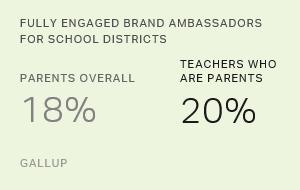Story Highlights
- Few teachers and parents represent their school districts positively
- Districts need to define clear identities and create measurements
- A focus on engaging teachers is key
This article is the second in a two-part series.
U.S. school districts could benefit from having many more "brand ambassadors."
The problem -- as reported in the first article in this series -- is that U.S. K-12 teachers who are parents are no more likely to be engaged with their child's school than are parents overall. Only about one in five parents (18%) or K-12 teachers who are parents (20%) are fully engaged -- an even lower percentage of customer engagement than in the banking, insurance and healthcare industries.
These startlingly low numbers have profound implications for school districts because of the effect they have on attracting the best teachers. District leaders who want to recruit and hire the best teacher talent should create a strong district identity and communicate it continually and consistently throughout the district.
This identity -- the combination of a district's mission or purpose, brand and culture -- is what sets it apart from the competition. It's the reason why highly talented teachers and principals choose to work for this school system over all the rest.
Creating More Brand Ambassadors
Here's how district leaders can create more brand ambassadors.
Define a clear identity. Leaders should clearly articulate the district's mission and make it a reality, not a tagline. The mission needs to inspire commitment in teachers, students and parents. Leaders also must articulate a clear brand that represents a credible, compelling promise to these key constituents. The brand has to attract teachers to work in the district and excite parents about sending their children there. Last, but not least, leaders should create a workplace culture that engages faculty and staff by making the district a great place to work.
Conduct a baseline measurement. To determine whether a school system's key constituencies understand its identity, leaders need to collect feedback from them, which will identify opportunities to make improvements that will have the greatest impact. This effort involves gathering feedback from parents about their perceptions of the district's identity and taking a baseline measure of parent engagement. Leaders must also ask teachers and staff for their feedback on the district's identity and measure their level of engagement with the district as a workplace. Comparing leaders' aspirations with parents', teachers' and staff members' perceptions reveal where they are aligned and where there are gaps, allowing leaders to correct these differences.
Take action to engage teachers. In a study of approximately 4,000 K-12 teachers, Gallup found that just under two-thirds strongly agree they have opportunities to do what they do best every day, while slightly more than half strongly agree that someone at work encourages their development.
The greatest opportunity to engage teachers may come from creating a workplace where teachers believe their point of view matters. The same study found that slightly more than four in 10 (43%) teachers feel their opinions count at work.
Gallup's analysis suggests that districts that want to improve teacher engagement can start by:
- ensuring that teachers do what they do best every day
- encouraging their development
- soliciting and taking action on feedback from teachers
Districts need to create an authentic identity that teachers are proud to identify with and contribute to every day. Developing highly engaged, high-performing schools will position districts for success. Great districts create strong, consistent identities, which helps them recruit and retain talented teachers. These teachers, in turn, recruit more great teachers and engage parents, building a strong team of brand ambassadors for the district. The outcome of this virtuous circle is student success -- which is every school district's ultimate goal.



